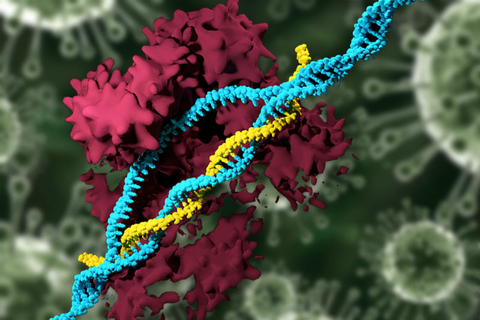|
 
- 现金
- 62111 元
- 精华
- 26
- 帖子
- 30437
- 注册时间
- 2009-10-5
- 最后登录
- 2022-12-28

|
2 studies show CRISPR might drive up cancer risk in edited cells
by Amirah Al Idrus |Jun 12, 2018 9:38am

A pair of studies published Monday found that CRISPR editing triggers a mechanism that protects cells from DNA damage. Cells that have this protective system are harder to edit, while cells lacking it are easier to edit. (MIT)
ShareFacebookTwitterLinkedInEmailPrint
Off-target, or unintended, editing is a key safety concern of CRISPR-Cas9, as it can lead to cancer and other side effects. Two new studies show that CRISPR editing could raise the risk of targeted cells—those being edited to treat disease—developing tumors.
A pair of studies published Monday found that CRISPR editing triggers a mechanism that protects cells from DNA damage. Cells that have this protective system are harder to edit, while cells lacking it are easier to edit. The catch? Cells that are easy to edit could be more susceptible to cancer-causing mutations.
“We managed to edit cancer cells easily, but when we tried to edit normal, healthy cells, very little happened,” said Emma Haapaniemi, of the Karolinska Institutet in Sweden. What’s more, about half of all cancer cells do not have this protective pathway, the researchers said.
Your Daily Newsletter — FreeEnjoying this story? Subscribe to FierceBiotech!
Biopharma is a fast-growing world where big ideas come along every day. Our subscribers rely on FierceBiotech as their must-read source for the latest news, analysis and data in the world of biotech and pharma R&D. To read on the go, sign up today to get biotech news and updates delivered right to your inbox!
SUBSCRIBE NOW
“When we looked at this further, we found that cutting the genome with CRISPR-Cas9 induced the activation of a protein known as p53, which acts like a cell’s alarm system, signalling that DNA is damaged, and opens the cellular ‘first aid kit’ that repairs damage to the DNA. The triggering of this system makes editing much more difficult,” said Haapaniemi, the first author of one of the studies, published in Nature Medicine. The other study, by Novartis, came to similar conclusions.
Editing cells without this “alarm system” could eventually boost the number of cells without protection against DNA damage. Blocking p53 in healthy cells slated for editing might be one way to “decrease the risk of selecting for p53-deficient cells,” but it could still open them up temporarily to mutations that cause cancer.
RELATED: MIT scientists propose a safer way to edit genes with CRISPR
The news drove down stocks for CRISPR biotechs—CRISPR Therapeutics, Editas and Intellia, to name a few. And while the researchers are calling for more work to determine whether CRISPR editing “may inadvertently raise cancer risk in cells,” they also said it’s hardly time to panic. After all, CRISPR has weathered a couple of storms, including a 2017 study saying the technology caused masses of off-target effects that was retracted this year.
“We don’t want to sound alarmist, and are not saying that CRISPR-Cas9 is bad or dangerous. This is clearly going to be a major tool for use in medicine, so it’s important to pay attention to potential safety concerns. Like with any medical treatment, there are always side effects or potential harm and this should be balanced against the benefits of the treatment,” said Jussi Taipale, of the University of Cambridge, who led the work while at the Karolinska Institutet.
|
|